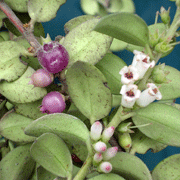James L. Luteyn and Paola Pedraza-Peñalosa
The New York Botanical Garden
|
|
Disterigma is a neotropical genus consisting of about 35-40 species, ranging from the highlands of Guatemala, south to Bolivia and east to Guyana. |
DISTERIGMA (Klotzsch) Niedenzu, Bot. Jahrb. Syst. 11:
160, 209. 1889. Vaccinium sect. Disterigma Klotzsch,
Linnaea 24: 57. 1851; Smith, A. C., Brittonia 1(4): 203-232.
1933; Wilbur, R. L., Bull. Torrey Bot. Cl. 119(3): 280-288.
1992; Luteyn, J. L., Fl. Ecuador 54: 253-286. 1996. Lectotype: Disterigma empetrifolium (Kunth) Drude.
Vacciniopsis Rusby, Bull. Torrey Bot. Club 20: 433. 1893. Type: Vacciniopsis ovata Rusby [=Disterigma ovatum (Rusby) S. F. Blake].Killipiella A. C. Smith, J. Washington Acad. Sci. 33(8): 242. 1943. Type: Killipiella styphelioides A. C. Smith.
Compact, bushy to straggly, terrestrial
or epiphyte shrubs. Leaves alternate, coriaceous, less than 3 cm
long, margin entire or crenate, the veination plinerved but usually obscure,
short-petiolate. Inflorescence an axillary cluster of 1-6, often
subsessile flowers subtended by a few, minute, subcoriaceous bracts;
pedicel short or
lacking; bracteoles apical along pedicel, immediately subtending
the calyx, obscuring the calyx and often the corolla as well. Flowers
(3-)4-5-merous, without odor; aestivation valvate (or calyx rarely
imbricate); calyx obscurely articulate with the pedicel; hypanthium
campanulate to short-cylindric; lobes triangular, suberect; corolla
subcylindric or campanulate-cylindric; stamens equal, 5-6(-8), usually
twice as many as the corolla lobes but rarely of the same number as the
lobes, about as long as corolla; filaments equal, distinct, ligulate,
longer or shorter than anthers, lacking spurs; anthers equal, dorsally
attached near the base, membranous, prolonged into (1-)2 tubules and dehiscing
by elongate, elliptical, introrse clefts or subterminal pores, lacking
disintegration tissue; pollen lacking viscin threads; ovary
inferior, (3-)4-5-locular; style filiform, about as long as the corolla;
stigma truncate; nectariferous disc fleshy, annular-pulvinate.
Fruit a coriaceous, thick-walled berry, blue-black or translucent white;
seeds sometimes mucilaginous.
Key to Neotropical Species Back to Top
At the moment, Paola Pedraza is preparing the monograph for Disterigma at The New York Botanical Garden.
